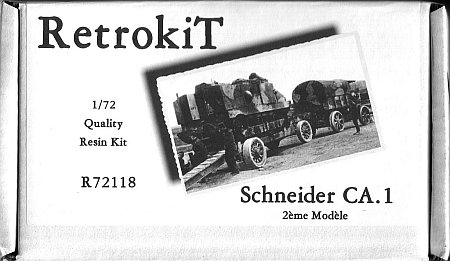|
Solfig
|
Schneider CA.1 2ème Modèle |
|||
|
Review by
- Al Magnus
|
||||
|
Solfig
|
Schneider CA.1 2ème Modèle |
|||
|
Review by
- Al Magnus
|
||||
 |
|
There are too few WW1 armour subjects available in injected plastic which is unfortunate. Outside of the nice injected plastic offerings from Emhar, this leaves the smaller resin manufacturers to fill the void. The Schneider CA.1 tank was not very successful. In combat it proved easy to knock out due to the exposed fuel tanks located on the side. This kit represents the CA.1 Type 2 version with extra body armour and the fuel tanks relocated to the rear of the tank framing the rear door. In all, some 400 Schneider CA.1s of all versions were manufactured by August 1918, when production ceased. At least one Schneider was delivered to Italy but it was not liked and there was no Italian production of the tank. After the war, the tanks were rebuilt as recovery vehicles and tank transporters. Six were sold to Spain in 1922, and from 1923 to 1926 were used in fighting in Morocco, the surviving four vehicles later taking part in the Spanish Civil War near Toledo on the side of the Republican army. I find it interesting that the box has the RetrokiT logo on it. At one time Retrokit was run by two partners, Dominic Jadoul and Marc Urwicz. Marc Urwicz is now based in France and continues to offer some of the Retrokit items under the new name Solfig. Dominic Jadoul is based in the UK and offers his part of the Retrokit line as RetrokiT. Receiving a box labelled RetrokiT from Solfig can only lead to confusion with the modeling public. So what kit are you actually getting when you see RetrokiT on the box? Is it a RetrokiT model or is it a Solfig model? Is it from old RetrokiT stock or a new Solfig item? You'd think that for brand recognition something should have been done to distinguish the Solfig line from the old Retrokit line - like maybe print some new Solfig labels to place over top of the RetrokiT printing on the box.
Life is full of disappointments. I had great expectations for this kit, hoping to add an important, though unsuccessful World War One tank to my collection. Unfortunately that's not going to be the case. In my view this kit is totally unbuildable. Review sample provided by Marc Urwicz of Solfig. |
| Back to Solfig Kit List | Back to Home Page |
Article Last Updated: 05 April 2012 |